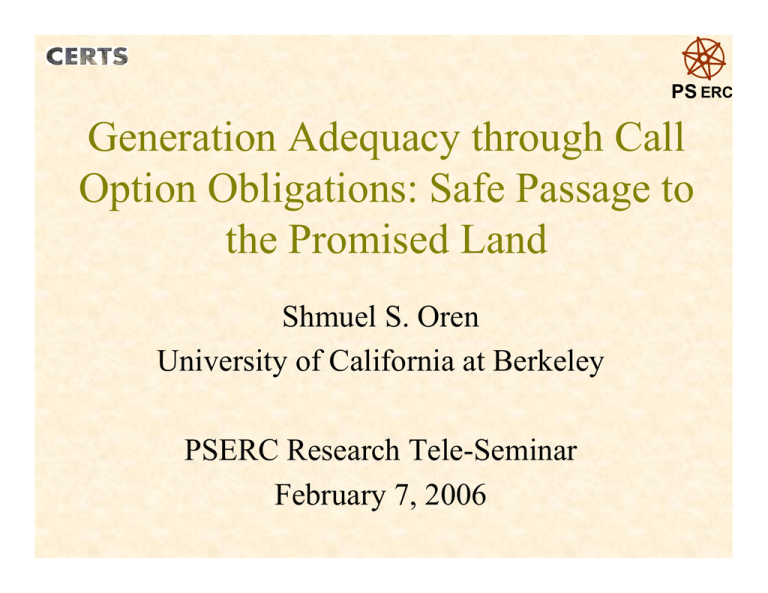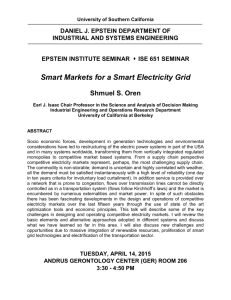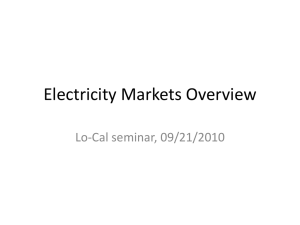
PS ERC
Generation Adequacy through Call
Option Obligations: Safe Passage to
the Promised Land
Shmuel S. Oren
University of California at Berkeley
PSERC Research Tele-Seminar
February 7, 2006
The Promised Land
PS ERC
• In a competitive electricity market generation companies
bear all the investment risk and consumers (LSEs) bear all
the price risk.
• Customers and suppliers are free to choose levels of
exposure to price risk through risk management and
contractual agreements.
• Forward markets and hedging instruments
enable parties to manage their risk exposure
• Competitive forces drive generation capacity, technology
mix and prices toward a long term equilibrium that reflect
supply and demand choices for reliability and cost.
• Fixed costs of generation capacity at long run equilibrium
are exactly covered by inframarginal costs and scarcity
rents
January 2006
All Rights Reserved to:
Shmuel Oren, UC Berkeley
2
Long Run Market Equilibrium in an
Energy – Only Market
Energy
Price
($/MWh)
PS ERC
Demand at 7:00 - 8:00 p.m.
Price at7:00-8:00 p.m.
Inframarginal Profits
Price at
9:00 10:00 a.m.
Scarcity rent
Demand
Response
Demand at
9:00 - 10:00 a.m.
Demand at
2:00 - 3:00
a.m.
Price at
2:00 3:00 a.m.
GEN 2
GEN 1
Q1
January 2006
GEN 3
GEN 4
Q2
All Rights Reserved to:
Shmuel Oren, UC Berkeley
GEN 5
Optimal
Capacity
MW
3
Issues that Must be Addressed in
Energy Only Markets
PS ERC
• Who will pay for reserve capacity that is required to
assure supply reliability.
• Steep supply function and uncertainties make scarcity
rents highly volatile and sensitive to market error in
determining the optimal capacity
• It is practically impossible to differentiate legitimate
scarcity rents from inflated prices due to exercise of
market power.
• Demand response is limited by technological barriers
and operational practices
January 2006
All Rights Reserved to:
Shmuel Oren, UC Berkeley
4
PS ERC
Issues in Energy Only Markets (Cont’d)
• Very high scarcity rents even if they are legitimate
are politically unacceptable (reason for price caps)
• Low levels of reserves foster collusive behavior
and market power
• Capacity shortages cannot be resolved overnight
and while the entry occurs the persistent scarcity
rents result in wealth transfers from consumers to
producers.
• Exposures in the electricity supply chain are not
properly allocated to insure voluntary, socially
efficient risk management practices by the market
participants (free riders)
January 2006
All Rights Reserved to:
Shmuel Oren, UC Berkeley
5
Classification of Capacity Mechanism PS ERC
Energy only
markets
Reliance on economic incentives
Capacity payments
Operating reserve
pricing
Strategic reserves
procurement
Contracting
obligations
Capacity
obligations
Regulated
regional
monopoly
Explicit demand for generation capacity
January 2006
All Rights Reserved to:
Shmuel Oren, UC Berkeley
6
PS ERC
Shortcomings of Traditional ICAP
• Artificial product – Demand derived from administrative
requirement and not based on intrinsic value
• “Bipolar” short term prices because supply cannot respond
• Short term product does not allow contestability by new
investment (can be fixed by extending product term and
lead-time)
• Disconnect from energy market
• No intrinsic deliverability requirement (location and price
of energy produced)
• Implicit strike price at CAP preempts a natural economic
penalty for nonperformance, eliminates spot price
advantage for unsubscribed capacity and discourages
demand participation.
January 2006
All Rights Reserved to:
Shmuel Oren, UC Berkeley
7
Implemented and Proposed Fixes to
ICAP
PS ERC
• Demand function for capacity (first adopted
by NYISO)
• CRAM (Centralized Resource Adequacy
Market-developed by NERA)
• LICAP (Locational ICAP – proposed by
NEISO)
• RPM (4 year forward market for capacity –
proposed by PJM)
January 2006
All Rights Reserved to:
Shmuel Oren, UC Berkeley
8
Properties of a Good Capacity
Mechanism
PS ERC
• Replicate investment incentives in functional energy only
market (forward contracting)
• Facilitate risk sharing between consumers and producers
• Provide intrinsic value to consumers in exchange for risk
sharing (not subsidy to generators)
• Incent new investment and enable direct participation by new
entrants (avoid the “missing money” paradigm)
• Provide stable income to generators to reduce cost of capital
in exchange for windfall profit potential
• Incent performance and have meaningful penalties for nonperformance
• Enable generators to opt out by increasing spot price potential
income in exchange for risk taking
January 2006
All Rights Reserved to:
Shmuel Oren, UC Berkeley
9
PS ERC
Desired Properties (cont’d)
• Enable load to opt out (self-insure) by avoiding
capacity payment in exchange for taking spot
price or curtailment risk
• Not interfere with risk management practices
• Allow self-provision through bilateral contracts
• Mitigate credit problem
• Obligation by LSE should reflect customer base
(follow the load)
• Easy phase out when market provides sufficient
insurance through contracting and load response
January 2006
All Rights Reserved to:
Shmuel Oren, UC Berkeley
10
Call Options as Price Insurance
PS ERC
Definition: A call option is the right but not obligation to
purchase one unit of power over the contract duration at an
agreed upon strike price
Spot
Spot
Payback to LSEs
holding option
Strike
Option Value
January 2006
Time
All Rights Reserved to:
Shmuel Oren, UC Berkeley
11
Mechanics of Backstop Call PS
Option Obligations
ERC
• Load serving entities (LSEs) required to hold at the beginning of
each month hedges in the form of forward contracts and/or call
options (with verifiable physical cover) totaling (100+X)% of
their next month forecasted peak load.
• Qualifying hedges must be at least three year forward looking
with forward or strike prices at or below a mandatory level set
by the regulator
• Mandatory strike price shall be high enough so as not to
interfere with risk management activities but significantly below
the energy price cap. (For example if the energy price cap is
$1000/MW then the mandatory strike price can be around
$600/MW).
January 2006
All Rights Reserved to:
Shmuel Oren, UC Berkeley
12
Call Option Mechanics (cont’d)
PS ERC
• Nonperforming capacity liable for difference between market
price and strike price (liquidation damages) plus penalty.
• Obligation may be locational with LMP-based settlement so
that option value (for the same strike price will be locationally
dependent)
• Uncommitted capacity can sell energy at market price above
strike but no higher than cap. (incentive for speculative entry
and uncommitted imports)
• Private contracts that meet the duration and strike price
requirement will count toward the LSE hedging obligation.
• Hedging obligations can be met by a portfolio of supply
contracts and curtailable loads (committed demand response).
January 2006
All Rights Reserved to:
Shmuel Oren, UC Berkeley
13
Call Option Mechanics (cont’d)
PS ERC
• Call options may be, self provided, procured bilaterally or
procured through a voluntary auction hosted by the ISO.
• Load can Opt out by offering a call option at the strike
price covered by a curtailable service contract (interrupt
when spot reaches strike)
• Deliverability can be assured by making call option
obligations zonal. LMP based settlement with same strike
price makes option prices locationally dependent (like
LICAP but without administrative prescription)
• Generator risk (and consequently the cost of options) may
be reduced by indexing the strike price to fuel cost or by
using “spark spread” call options
(spark spread=electricity price-heat rate adjusted gas
price)
January 2006
All Rights Reserved to:
Shmuel Oren, UC Berkeley
14
Spark Spread Option
gas spot
price
8000 heat
rate
PS ERC
power
spot price
Hr*Sg
Spark Spread
Se ($/MWh)
January 2006
All Rights Reserved to:
Shmuel Oren, UC Berkeley
Time T
15
Call Option Value
in a Price-Capped Energy Market
PS ERC
Energy Price $/MWh
Cap
Strike
Annualized
Call option value
$/MW
Price duration curve
8760
January 2006
All Rights Reserved to:
Shmuel Oren, UC Berkeley
Hours
16
Call Option Prices as Function of
Generation Capacity based on
Opportunity Cost of Selling at Spot
Energy Price
Annualized Call Option
Value
Call Option Price
Per Hour
Capa
ci
ty
Cap
Strike
PS ERC
Cap -Strike
P*
8760
Price Duration Curve
Q*
Capacity
Hours
Implied Demand Curve for Capacity
At optimal capacity Q* the call option price
P* = Average Hourly {CT fixed cost – CT energy profit with price capped at Strike}
January 2006
All Rights Reserved to:
Shmuel Oren, UC Berkeley
17
Comparison to Proposed LICAP
Demand Function in NE
LICAP
• Demand curve is explicit – administrative
• ISO procures all available capacity and adjusts
LSE obligation accordingly (discourages selfprovision)
• Disincentive for self provision
• No opt out for load
Call Options
• Strike price below cap and ability to sell above
strike for non committed units creates intrinsic
market value for option. (non delivery
=financial liability)
• Gens selling option are liable for providing
energy at reduced rates (strike)
• Option price is implied by opportunity cost of
selling energy above strike (market based)
• Option obligations never exceed target
capacity-capacity beyond target assumes risk
of cost recovery
January 2006
PS ERC
Price
2×EBCC
EBCC
Target Capacity
Capacity
Note: EBCC = expected benchmark carrying cost (annualized fixed cost of frame unit)
All Rights Reserved to:
Shmuel Oren, UC Berkeley
Source: Cramton and Stoft 2004
18
The Time Step Misalignment
Dilemma
PS ERC
• LSEs want hedging obligations to be short
term (load varies, no long term contracts
with customers, credit requirements)
• Generators want call options to be long term
(can take it to the bank as collateral for
investment loans)
• How do we bridge the gap?
January 2006
All Rights Reserved to:
Shmuel Oren, UC Berkeley
19
Central Procurement
PS ERC
– Works like an ancillary service product
– ISO conducts an annual central auction for annual three year
forward call options on energy with a specified strike price
– Procured quantity is based on forecasted load and reserves
requirements which may be zonal
– Option offered must be covered by existing capacity, three year
forward interruptible contracts or bilateral contract with min
three year duration and price at or below strike price.
– LSEs holding long term contracts and curtailable load contracts
with appropriate duration and price can self provide by offering
call options against these contracts into the auction.
January 2006
All Rights Reserved to:
Shmuel Oren, UC Berkeley
20
Central Procurement (cont’d)
PS ERC
– LSE obligation (and share of cost) determined Monthly based
forecasted monthly peak load.
– Cost of options allocated on a per MWh basis and over time based
on monthly LOLP calculation.
– Payment to sellers and allocation of cost to LSEs at performance
time (ISO passes payment through).
– For LSEs who self-provided their full obligation option revenues
offset costs.
– Providers of options required to offer contracted capacity at
contract strike price and offer any additional balancing energy
(beyond contracted capacity) at market clearing prices.
– Failure to perform entails financial liability for the difference
between market price and strike price times the amount of
undelivered energy (liquidation demages) plus penalty.
January 2006
All Rights Reserved to:
Shmuel Oren, UC Berkeley
21
Implementation in Brazil
•
•
•
•
•
•
PS ERC
A central procurement auction for energy call options with physical cover
was conducted in Brazil in December 2005
Generators were allowed to submit option premium offers for 15 year call
options at self-selected strike prices (ideally reflecting their fuel cost)
Offers were selected based on a cost/benefit index accounting for the
offered premium and the corresponding strike price.
Procurement cost is passed on to DISCOs who must have contract cover
for 100% of their load.
Under the call option contract the DISCO has the right but not the
obligation to purchase the energy at the strike price, thus enabling
consumers to benefit from low spot prices (below the strike price) when
hydro power is plentiful.
Reference: “Energy Call Options Auctions for Generation Adequacy
in Brazil,” Bezerra, Barroso, Granville, Guimarães, Street and Pereira.
January, 2006, Submitted to IEEE PES Toronto meeting.
January 2006
All Rights Reserved to:
Shmuel Oren, UC Berkeley
22
Summary
PS ERC
• Self provision option enables smooth transition to voluntary
insurances. As the market matures individual hedging
obligation may be relaxed if the market as a whole proves to be
properly hedged.
• Multiple means of meeting hedging obligation ensures balance
between investment, demand response and risk management
• Hedging products are long term to facilitate new investment
response by transferring risk from the investor to consumers
(represented by the LSE)
• Enables reserve generation capacity to secure a stable income
stream for fixed cost recovery in exchange for a tangible
obligation to produce energy at a reasonable price when needed.
• Unlike forward contracts, call options do not have a “take”
obligation so the LSE can be required to hedge a larger quantity
than expected peak demand.
January 2006
All Rights Reserved to:
Shmuel Oren, UC Berkeley
23
PS ERC
Summary (cont’d)
• LSE obligations can be revised monthly to reflect changes
in customer base.
• Call option obligation functions as mandatory insurance
where capacity product is linked to energy production
capability and deliverability.
• Market price of option is driven by opportunity cost of
selling energy above strike price and it will decline
naturally with increased generation capacity (no need for
administrative demand curve and procurement does not
need to extend beyond target capacity)
• Self-provision through prudent risk management practices
by LSEs and demand response will lead to natural sunset
of the regulatory obligation.
January 2006
All Rights Reserved to:
Shmuel Oren, UC Berkeley
24
Ultimately, demand response and risk
management practices will evolve to the point PS ERC
where the Promised Land can be reached.
January 2006
All Rights Reserved to:
Shmuel Oren, UC Berkeley
25




